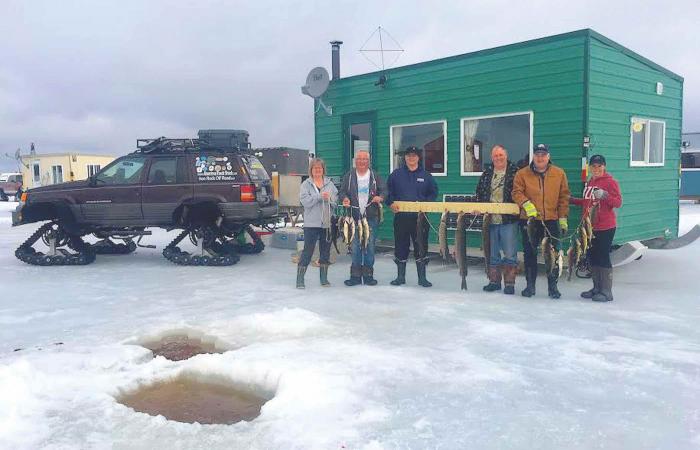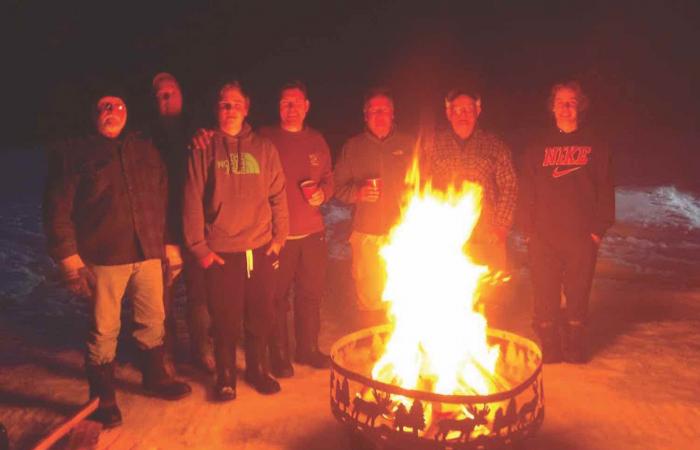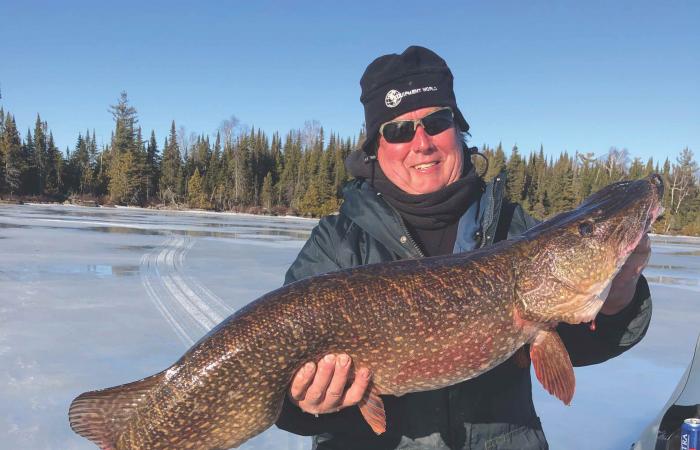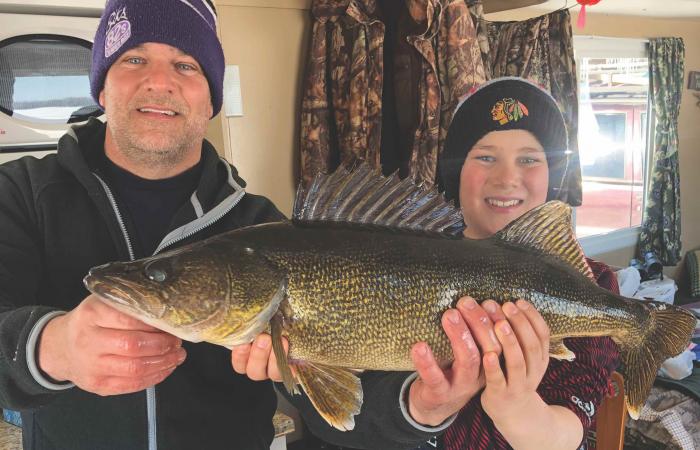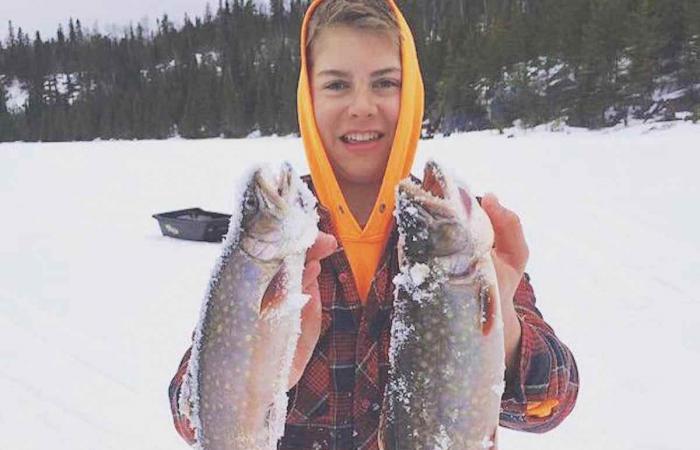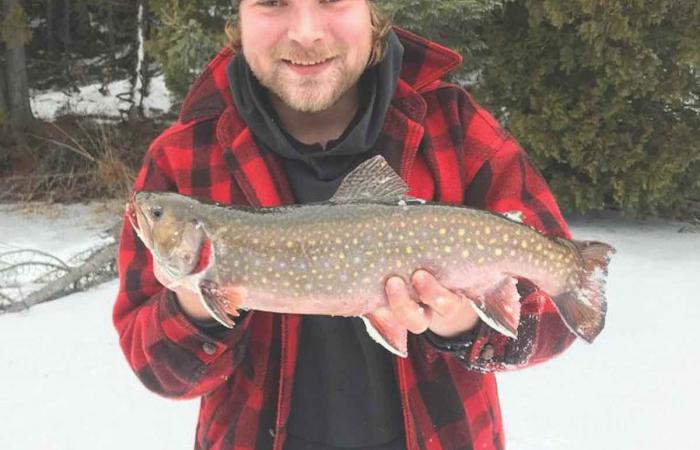Short days, cold nights. The wide snowy surface of a frozen lake, the sky like a vast ocean of blue overhead. Beneath it all, hundreds of fish mocking the frigid life above, so difficult to catch but so tempting to try. As the temperatures begin to plummet and our lazy autumn rolls into the grip of a northern winter, I spoke to several fishermen about the strategies of connecting with nature through a foot or two of solid ice.
“I’ve been ice fishing since I was a kid,” says enthusiast Ernie Ukrainec, Technical Sales Manager of Equipment World in Thunder Bay. “And I have to say it’s much more enjoyable if you have some sort of shelter. Even if it’s a portable pop-up tent, it’ll provide shelter from the cold and wind, and give you the opportunity to spend the night, or the weekend, on the lake.”
In Thunder Bay and region, the ideal shelter is an ice hut.
“A hut could be the difference between a miserable day/night out on the lake and a really enjoyable time,” says retired EMS paramedic, Gordon Conrad. “In fact, some folks build small houses with all the comforts of home.”
With the sheer length of our winters and our multitude of lakes and rivers, ice fishing is simply a part of life in Thunder Bay, so Conrad was ‘inducted’ into the sport when he moved to the region in 1990. Now, he and his three sons spend as much time on the ice as possible during the long winter months.
“We bought a small pop-up shelter at Canadian Tire,” he says. “And it’s great because you can throw it up anywhere in minutes. But sometimes, when we’re spending a night or two on the lake, we head out to one of the really great rental places for a wooden ice hut.”
Another seasoned angler, Ted Roblin has been ice fishing for over 18 years, and while he doesn’t own his own hut, he agrees with Ukrainec and Conrad on their importance.
“Strong winds and frigid temperatures can interfere with the enjoyment and overall experience when out on the lake,” he says. “So, an ice hut helps you shelter from the elements. A travel fold-up type could be set up in less than 20 mins, and it can be moved around the lake to find better fishing spots. On the other hand, a larger, more permanent enclosure is more comfortable. They get brought onto the lake by truck or snow machines, and if I get the choice, I’ll usually pick one of these.”
Ice fishing is a popular pastime in Northwestern Ontario, and there are as many ways to pursue this hobby as there are fishermen/women. A resident of Kakabeka, Roblin likes to explore new fishing spots on some of the smaller lakes around the area, and his fish of choice is speckled trout or walleye (also known as pickerel). Conrad is similar, living in South Gillies and preferring to fish on smaller lakes stocked with brook trout. And while Ukrainec will catch perch, pike and whitefish, his target fish is walleye. Because of this, he does most of his ice fishing on Lac Des Mille Lacs, home of the largest ice hut community in Northern Ontario where there is rarely a bad spot on the lake for the sought-after walleye. It’s an hour and a half from the city, so for him (and many others), he opts for a wooden ice hut, making a weekend on the lake not only possible, but enjoyable.
“Ours is permanently parked in one spot on the lake for the season,” Ukrainec says, “So each weekend, we just have to light the stove for heat once we get there. We prefer to be off the beaten path, and we have a jeep with tracks on it so we can easily get around and away from the plowed ice road.”
That winter road connects Shacks Landing on Sawmill Bay with Coffin Island at the centre of the lake. In fact, during most winters, Lac Des Mille Lacs sees an entire village of ice huts spring up on the frozen surface, with upwards of 150 huts at the height of the season. It’s clear that many experienced fishers enjoy the fellowship and camaraderie as much as the fish, and Roblin says that the experience is not just about fishing but about spending time with friends and family. This is something with which Conrad enthusiastically agrees.
“Sometimes, a small gathering turns into a community,” says Conrad. “There, you have like-minded people all having fun and enjoying the outdoors together. It’s really kind of cool. Literally.”
This past winter found many families looking for healthy outdoor activities during the months of Covid lockdown. Many of them took to the lakes to fish, snowshoe, and explore the rugged beauty of our northern winter. Because of this, various ice hut rental outfitters saw a shift in their business, moving from tourism to more regional, domestic patronage. I spoke to Kris Selagi, Owner/Operator of Lac Des Mille Lacs Sugar Shack Rentals, about the benefits of renting a hut when taking to the lake.
“It’s a great place to rent ice huts, get away and stay cozy warm while fishing on the winter ice,” says Selagi. “You can drive the ice road right up to the door and fish in the comfort of your own hut. I can’t tell you how excited I am for this year’s ice fishing season and many more to come.”
Sugar Shack’s ice hut rentals range from small, shed-like structures to portable cabins that sleep 5. They come with cots, wood stove, cookstove, 120V AC lights and outlets for charging phones or laptops. For serious ice fishermen and women, a wooden structure is the only way to go if they’re going to be spending more than a day out on the ice. Ukrainec decided to build his own instead of renting, and I asked him about what went into building the perfect ice hut.
“A heater fueled by wood, oil or propane is essential,” he says, “And if you’re going to spend the night, you have to make sure your heat source is safe with good ventilation and a carbon monoxide detector. You’ll also need sleeping accommodations, cooking facilities (BBQ, propane stove, smoker, etc), some sort of bathroom facility and a generator for power. I like lots of large windows in the hut so that you can see your outside lines, but if it’s really cold, you can do all your fishing inside with holes in the icy floor.”
For a very different perspective, I talked to Henry McMeekin, an avid fisherman who calls Scotland home. He has fond memories of summer fishing on Lake Superior, but he also has stories galore about ice fishing as far north as the Arctic.
“I’m sorry to say but Alaska has the best ice fishing in the world!” he says in his deep Scottish brogue. “Ling, flat fish, skates, bass and of course, salmon. So many salmon. They’re huge. If you can’t catch a salmon in Alaska, you’d have to be dead!”
While there were no ice hut villages or other human fishermen like at Lac Des Mille Lacs, McMeekin has faced stiff ‘competition’ for the salmon from time to time.
“Without other people around, you have to really trust your guide,” he says. “Once I was pulling a big salmon off the line when the guide flagged me down. 100m away, there was a grizzly bear fishing as well, so we carefully packed our gear and left the fish to him!”
I asked McMeekin about whether he used a hut or a tent when ice fishing in the Arctic.
“In Alaska, it’ll be -30 or -40 when you head out first thing in the morning. We used tents that are double nylon with an air pocket, outer and inner skin, metal poles, and covered in plastic. You’ll also need a very big drill to get through the ice, which could be 3-4 feet thick. We’d use a hand line not a rod, that has 3 or 4 hooks with bits of fish or corn soaked in fish paste. There’s a wee heater in the tent, but your feet constantly stay cold. In fact, my small digital camera froze once.”
As one who has never ice fished in my life, I wondered what other things would be considered ‘essential’ when spending days in sub-zero temperatures on a frozen lake.
“Safety first,” says Ukrainec. “Be sure you know the lake and where the ice is safe to travel on.”
“DON’T go out on the day the lake decides to send you a blizzard,” says Conrad, and I know he is not joking. “Or when it suddenly decides to plummet to -40C overnight. NOT that I have ever done that in my life.”
“Go with someone that has experience and is willing to teach you the essentials,” says Roblin eagerly. “Don’t go solely to catch; rather, go for experience and the fun!”
“And watch out for grizzlies.” McMeekin grins.
Hmm. I think I’ll be opting for the hut. The wooden one with wifi. And lots of blankets and woolly socks and maybe a bottle of Sauvignon Blanc to pair with that fish if Paul Inksetter approves. Now, if only I could get someone to catch, filet and cook it for me, it would be paradise.
For more information on Ice Huts and Ice Fishing in Northwestern Ontario, contact Sugar Shack Rentals at www.sugarshackrentals.com, or Thunder Bay Tourism at www.visitthunderbay.com.

